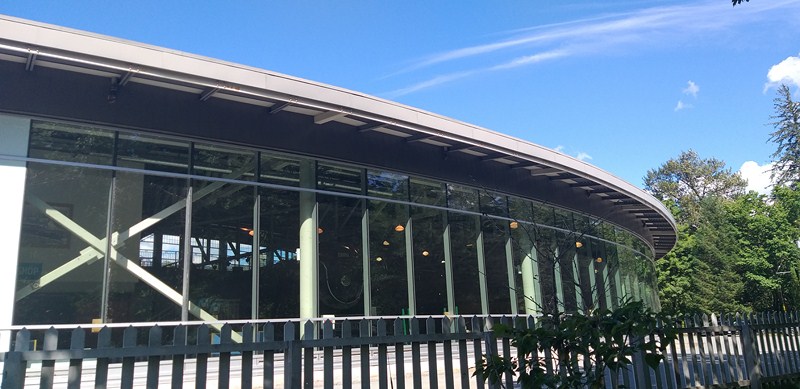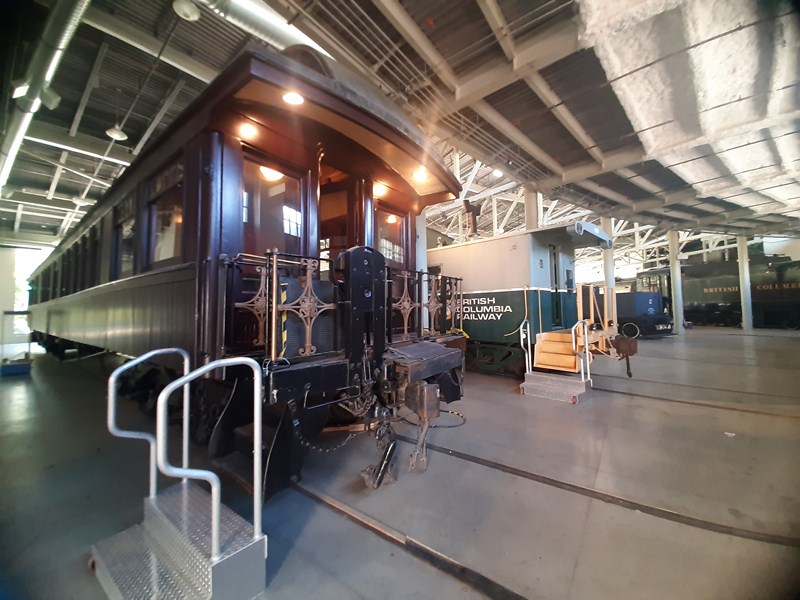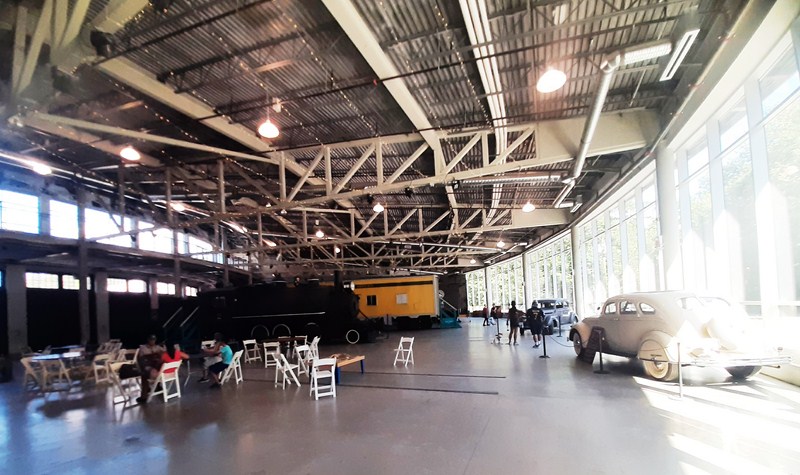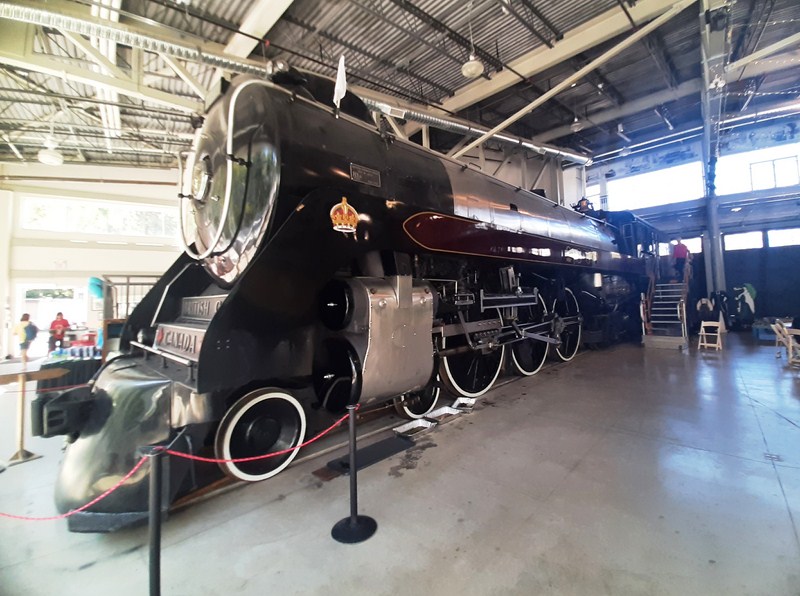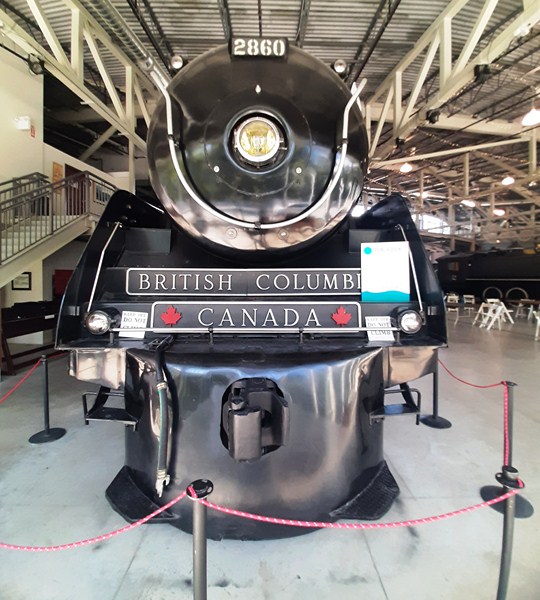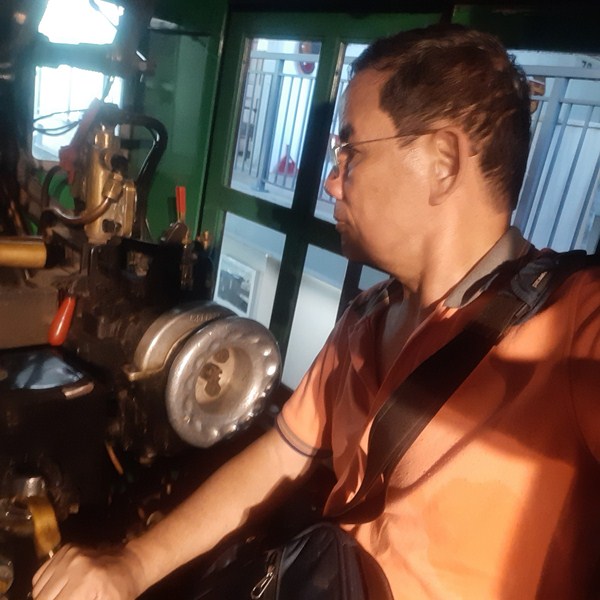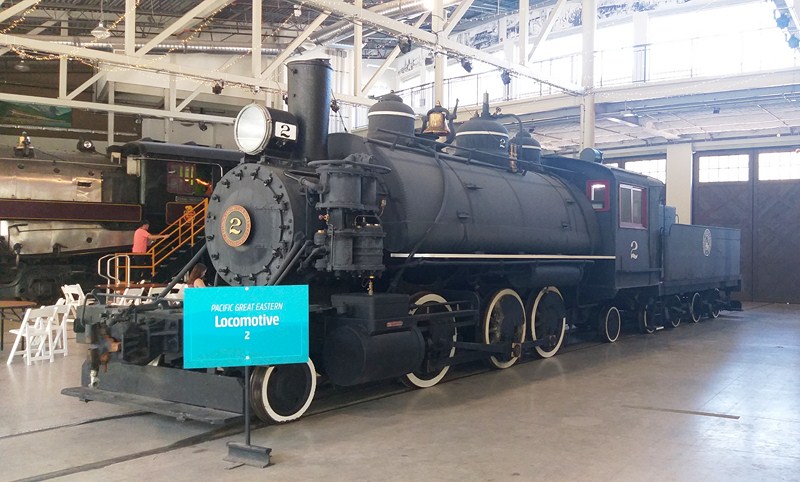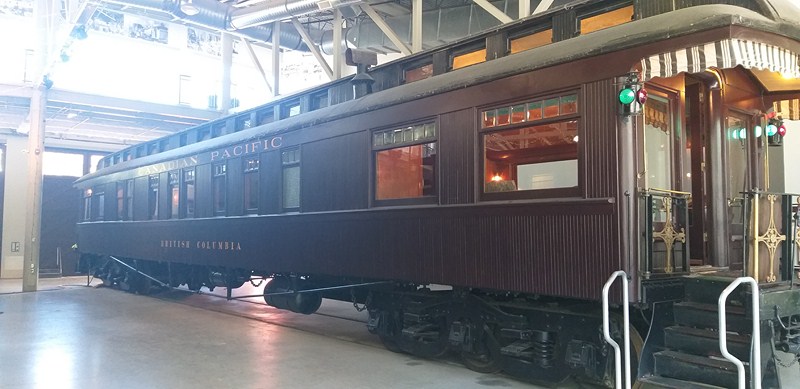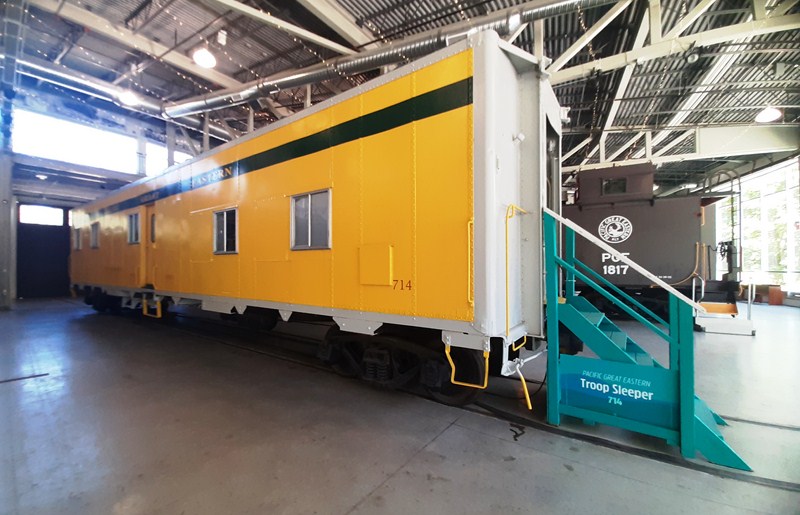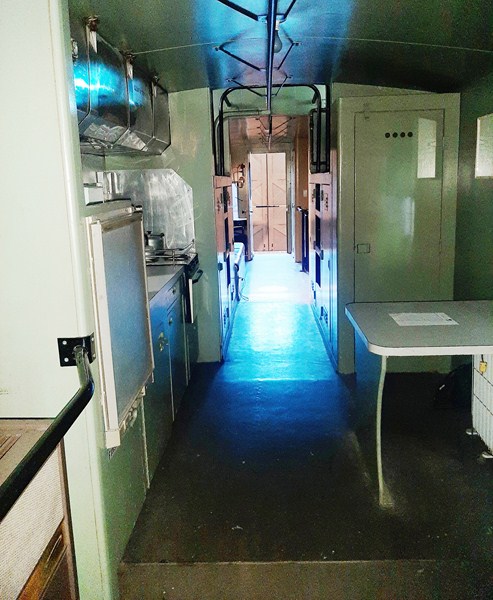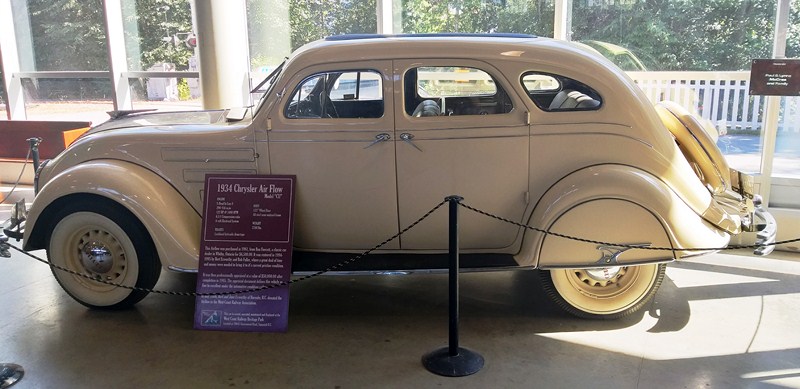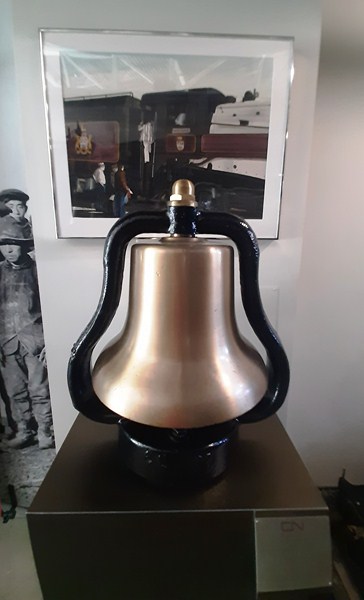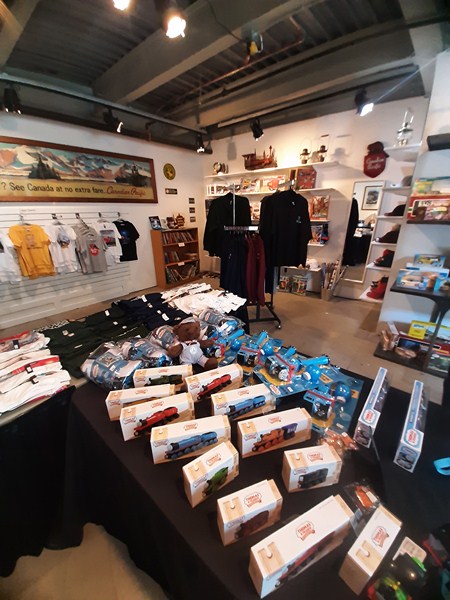After our Mini-Rail ride, we next proceeded, indoors, to the spectacular CN Roundhouse & Conference Centre, the largest meeting facility in the Sea to Sky Corridor.
 Opened last June 30, 2010, this fully geothermal roundhouse, with three levels, has also become a major community events space, with many banquets, weddings, public markets and other functions regularly held at the site.
Opened last June 30, 2010, this fully geothermal roundhouse, with three levels, has also become a major community events space, with many banquets, weddings, public markets and other functions regularly held at the site.
 The 22,000 sq. ft. building, with its over 280 ft. long curving glass feature wall and its upper level viewing deck, offers spectacular views of the Heritage Park and the surrounding mountains in all directions. A vintage railway turntable, to move the trains in and out, was refurbished and installed and is fully operational.
The 22,000 sq. ft. building, with its over 280 ft. long curving glass feature wall and its upper level viewing deck, offers spectacular views of the Heritage Park and the surrounding mountains in all directions. A vintage railway turntable, to move the trains in and out, was refurbished and installed and is fully operational.
It is also a grand showcase for a collection of precious pieces of rolling stock in climate-controlled comfort. Two are locomotives (Canadian Pacific Railway Royal Hudson 2860 locomotive and Pacific Great Eastern 2-6-2ST locomotive), one business car (British Columbia Business Car) and one is a troop carrier (Pacific Great Eastern Troop Sleeper 714).
The magnificent Canadian Pacific Railway Royal Hudson 2860 locomotive is the Crown Jewel of the collection. One of 65 ‘Hudson’ type 4-6-4 steam locomotives built for the CPR by Montreal Locomotive Works (MLW), this series of engines was numbered 2800 to 2864 and the first one was delivered in 1929.
Starting with No. 2820, the Hudsons got the streamlining treatments so popular in the 1930’s. Five CPR Hudsons were saved (Nos. 2816, 2839, 2850, 2858 and 2860).
During the visit to Canada by King George VI and Queen Elizabeth in 1939, Locomotive No. 2850 (now at Exporail near Montreal) was assigned to haul the Royal Train, performing flawlessly and impressing the King greatly. The CPR received permission to designate the streamlined Hudsons “Royal” and eventually each locomotive was equipped with a crown fastened to their running boards.
The engine and loaded tender weigh 293,770 kgs. (648,000 lbs.), has a tractive effort of 19,2004 kgs. (42,250 lbs.) and is capable of speeds of 144 kph (90 mph). The locomotive and tender have a total length of 27.27 m. (90’ 10”) and is 4.7 m. (15’ 10”) high. The tender has a capacity of 54,600 liters (12,000 gallons) of water and 18,614 liters (4,1000 gallons) of fuel oil.
Engine 2860, finished in June 1940, was restored for a proposed Railway Museum in Vancouver. In 1974, the Province of British Columbia bought the locomotive for an excursion train and it ran on the BC Rail track from North Vancouver to Squamish. In 2000, the province leased the engine to the district of Squamish for display and restoration at the West Coast Railway Heritage Park (now the Railway Museum of British Columbia). You can climb into the cab and ring the bell.
The Pacific Great Eastern 2-6-2ST locomotive, built by Baldwin Locomotive Works in Philadelphia, Pennsylvania, in February 1910, is a “Prairie” type weighing over 90 tons in working trim and delivering about 22,000 lbs. of tractive effort with a boiler pressure of 185 lbs.
The cylinders are 16” x 24” and the engine is equipped with Stephenson valve gear. The ‘ST’ denotes the unique saddlle tank design for the water tank above the boiler.
The British Columbia Business Car, built in 1890 by Barney & Smith of Dayton ( Ohio) as the sleeper Sherbrooke for the Canadian Pacific Railway, was rebuilt, in 1912, in CP Angus as a Business car No. 16 and used all across Canada until it was retired. In 1961, it was purchased from the CPR by founding members of the West Coast Railway Association (WCRA). The car was then leased to the Victoria Pacific (a tourist railway operator) until 1971.
In 1983, the car was returned to the WCRA and, by that time, it had suffered serious damage. That same year, restoration began and was completed on July 30, 1990, in time for its 100th birthday. It is estimated that 80,000 person hours and $360,000 have gone into bringing British Columbia to her present condition.
As a business car, it would normally carry a complement of three – a Railway Executive, his assistant and a Steward. However, the car could sleep up to 10 people in a comfort rarely equaled today. The interior is Honduran mahogany, inlaid with birch, maple and walnut and finished with 12 coats of varnish, each one sanded between coats and finally French polished. All the fittings are solid brass and the car rides on 6 wheel trucks.
The Pacific Great Eastern Troop Sleeper 714, built by the Pullman Company during World War II to alleviate the shortage of sleeping cars to transport troops in the US, was built with Allied Full Cushion high speed trucks and was designed to be converted into baggage cars thus ensuring a ready sale when the war is over. Both troop sleepers in the collection saw service on the Alaska Railroad during the latter days of the war.
There are two cabooses (a crewed North American railroad car coupled at the end of a freight train that provide shelter for crew) – the British Columbia Railway Extended Vision Caboose 1859 and the Pacific Great Eastern Caboose 1817.
British Columbia Railway Extended Vision Caboose 1859, featuring the beautiful two-tone green and BC Trillium livery, was originally built by the PGE home shops in 1969.
The Pacific Great Eastern Caboose 1817 was one thirty cabooses were built, numbered from 1811 to 1840. In 1955, No. 1817 was rebuilt, from PGE stock car No. 503, in the PGE car shop.
In their conversion, they were stripped the caboose to the frame and rebuilt it using conventional methods. They sheathed it , inside and out, using marine plywood. The cupolas were constructed with sheet metal and welded for extra strength.
Warm and comfortable, they were equipped with a standard caboose cook stove and 3 bunks for crew. ST denotes the unique Saddle Tank design for the water tank over the boiler.
A rare 1934 Chrysler Air Flow Model CU, noted for its aerodynamic body design (far before its time), was purchased from Ron Fawcett (a classic car dealer from Whitby, Ontario) in 1981 for $6,500, by William Albert Exworthy whose joy was restoring antique cars. He restored this car from 1994 to 1995 and, on May 2006, donated it to the museum.
There’s also a 1937 Ford Fordor Sedan rail inspection car which was in service till 1962. It had the perfect wheelbase to run on top of the rails, with flanges mounted behind the wheels.
Also on display here is the original brass bell from Canadian National 2-8-2 3449;; a scaled model of a Shay 3 Cylinder Logging Locomotive; an original Stanley Park miniature train; a luggage wagon; a Max Jacquiard painting of Canadian National 6060; and historical Canadian Pacific and Canadian Northern Railway advertisements.
Their Gift Shop offers a selection of Railway Museum of British Columbia apparel; scale model trains,model kits, die-cast models, DVDs (featuring Canadian Pacific Royal Hudson No.2860); puzzles and toys; and merchandise celebrating a Day Out with Thomas and North Pole Express events.
Railway Museum of British Columbia: 39645 Government Road, Squamish, British Columbia V8B 0B6. Tel: 604-898-9336. E-mail: Info@wcra.org. Website: www.wcra.org. Open every Saturday and long weekends, Sundays all summer, 10 AM – 5 PM, select Thursdays, 10 AM – 3 PM. Group Tour events Special Access. Admission (plus taxes): ($25 (adults, 19–59 years), $20 (seniors, 60+ years), $18 (students ages 12+), $10 (children, 6-11 years), $75 (family, where members must reside at the same address). Toddlers, under 5 years of age, are free admission. Admission tickets usually include all rides and activities.
How to Get There: the museum isn’t so easy to find unless you have a good map or GPS. Driving past the main intersection with Petro-Canada, 7-Eleven & McDonalds, turn left at either of the next two exits (Industrial Way or Commercial Way) then turn right on Queens Way and follow that a short distance until it merges with Government Road at the stop sign. Proceed across the BC Railway Crossing (after looking both ways). The entrance to the museum will be on your right.

